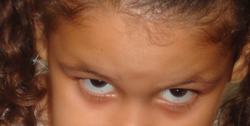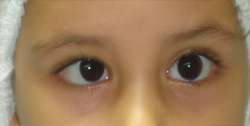
Muscle Transpositionn
Muscle Transposition
- Horizontal rectus muscle transposition in A & V pattern.
Horizontal muscle transposition for A and V-patterns
- Vertical transposition of horizontal muscle insertions is an effective means of collapsing an A- or V-pattern. This is true only if there is no significant oblique overaction.
- If oblique overaction is present, appropriate oblique strabismus surgery should be used.
- The rationale for vertical transposition is based on the observation that the strength of a horizontal rectus muscle is increased when the eye is vertically rotated in the direction opposite to the direction of its transposed insertion.
- Lowering the insertion of a horizontal rectus muscle improves the effect of this muscle when the eye is in elevation.
- Therefore, an esotropic V-pattern would be best improved by moving a recessed medial rectus muscle inferiorly, which produces more adduction in up gaze and less in down gaze.
- Similarly, displacing a resected lateral rectus muscle insertion superiorly decreases its abducting effect in up gaze while increasing the effect in down gaze.
-
 A medial rectus muscle, whether resected, recessed, or simply transposed is always moved toward the apex of the pattern. Thus the medial rectus muscle
is displaced inferiorly in V-patterns and superiorly in A-patterns.
A medial rectus muscle, whether resected, recessed, or simply transposed is always moved toward the apex of the pattern. Thus the medial rectus muscle
is displaced inferiorly in V-patterns and superiorly in A-patterns.
- The most important points: Determining the site for scleral reattachment of the muscle, as it is important not to advance or recess the muscle inappropriately.
- Measuring the distance to muscle’s new insertion radially from the limbus.
PREOPERATIVE V pattern esotropia




V pattern Esotropia
PREOPERATiVE

POSTOPERATIVE




 /
/




